
History
The Museum of Origins was founded in 1942 by Ugo Rellini, Full Professor of Palethnologyat "La Sapienza" University of Rome. It was initially created from an early nucleus of collections donated by Rellini himself. Over time the museum was enriched through the research activities of the PalethnologyInstitute, exchanges with other museums in Italy and abroad, and loans granted by various Italian Superintendencies. Most artefacts are from surveys and archaeological excavations mostly carried out in central-southern and insular Italy.
In over fifty years since its creation, the museum exhibition was renewed for the first time in 1962, then once more in 1992, including a complete architectural renovation of the premises, for a more functional exhibition itinerary, and special areas for teaching activities.
The aim of the exhibition itinerary is to frame different material from a chronological and cultural point of view, and to reconstruct their methods of production and use, illustrating different aspects of archaeological research. Archaeological artefacts are exhibited with detailed explanation and iconography.
The itinerary is underpinned by a chronological theme, from the earliest manifestations of human culture to the early Palaeolithic, up to the First Iron Age, or rather the dawn of history. In-depth thematic studies regarding social organisation, subsistence activities, funerary rituals and technology enable us to understand the lifestylesand the ideological world of past communities, in greater detail. The material on display is mostly original, integrated with a few casts and reconstructions.
The museum is open to the public and guided visits can be organised for schools and groups.
Collections
Prehistoric archaeology studies past societies before the beginning of written records and its main aim is the reconstruction of the environment, economic activities, the social and political organisation of these human groups. Sources of knowledge include objects, usually made from non-organic material (stone, ceramics, metal), the remains of residential structures, tombs, etc., unique traces of human actions and behaviour, requiring adequate interpretation.
The Museum of Origins contains an abundance of Italian prehistoric material on display, spanning over an extremely long period of time, from the Lower Palaeolithic to the First Iron Age. Brief explanations on each of the major periods of prehistory are integrated with graphic examples and illustrations of the long story of the physical evolution of mankind. Reproductions of craniums belonging to different genera and species, from Australopithecus africanus, Homo ergaster up to Neanderthal and Homo sapiens, arranged in the recognised evolution sequence, based on the most recent discoveries.
The most ancient artefacts include flint tools dating back to the Lower Palaeolithic, dated at approximately 500,000 years, and a skull of Elephas antiquus (200,000 - 130,000 years ago), discovered during excavation works for the completion of the Via dei Fori Imperiali in Rome.
The museum collections also include material from important archaeological sites such as Coppa Nevigata, with its impressive stratigraphy spanning from the early Neolithic to the Bronze Age, or exceptionally well conserved wooden artefacts from the pile-dwelling village of Ledro, dating back to approximately 4,000 years ago, rich burial objects from the Bronze Age funerary grave of Manaccore (Foggia), or those from protovillanovian cremation burial site of Sasso di Furbara-Rome, or bronze objects from the First Iron Age hoard of Piediluco. In addition to artefacts on display, there are the reconstruction of a Copper age burial from Cava Koch (Marche, mid 4th millennium BC), and scale model of the eneolithic dwelling of Maccarese (Rome), of a pile-dwelling village and a late Bronze Age Sardinian nuraghe.
Research
The Museum of Origins contains a rich collection of Italian and European prehistoric and protohistoric materials. As part of the Department of Classical Studies, it involves other disciplines including Palethnology, Prehistoric ecology, Prehistory of the Near and Middle East, European Protohistory, and the Prehistoric Ethnography of Africa.
In virtue of its location inside a University faculty, its "open laboratory" configuration, enabling students to use scientific equipment and participate in archaeological, archeometric or restoration laboratory activities, as well as its direct and constant contact with schools, the Museum of Origins is an excellent link between three fields which may initially seem distinct: research, teaching and scientific knowledge.
The laboratory-warehouse annexed to the museum contains collections which are not on display but can be consulted upon request, as well as material from archaeological excavations in progress, which are also studied and documented here. Students of University Archaeology courses actively participate in these activities during practice sessions and traineeships. The museum is also home to an important functional analysis and experimental archaeology laboratory, where ceramics, lithic and bone industry artefacts are reproduced, their construction sequences are analysed and studied using state-of-the-art technologies (metallographic, polar light microscopes, stereoscopes). The archeometry laboratory is also equipped with a thin section. The museum hall is a regular venue for university courses, conferences and seminars.
The offices of Origini editorial team are located in the Museum. Origini is ajournal founded in 1967 by S.M. Puglisi, which publishes scientific contributions in the fields of palethnology and anthropology on an annual basis.
Puglisi Director of the Museum of Origins
As director of the Museum of Origins - founded by Rellini in 1942 - Puglisi reorganised its structure and exhibition itinerary on the occasion of the 6th International Congress of Prehistory and Protohistory, held in Rome in 1962. New showcases, new exhibition criteria reflected the director's methodological grounding in an educational perspective. The ultimate aim was to capture cultural aspects through objects, underlining the problems which academics must tackle in their research, rather than focus on the conclusions themselves. Puglisi was convinced that all these features should characterise a university museum. Puglisi first became professionally involved in university life after a long career in Superintendencies, where direct contact with the territory and Museums had contributed to his intrinsic skills: for example, he personally contributed to the set-up of the prehistoric section of the Ancona Museum during the late 50s.
The exhibition’s organisation was based on a traditional chronological itinerary of Italian prehistory, from the dawn of time up to the Iron Age, perfectly linked to the collections of the adjoining Museum of Etruscology. The showcases were located in three large, connected halls, and were arranged clockwise, for a more palpable chronology and in order to avoid "return" itineraries. The cases were made from crystal, with sliding shelves. There was cold wall lighting, to avoid shadows and light contrasts which were too strong. There is a clear sense of an awareness of museographic and exhibition issues which were resolved in a manner that we may take for granted, but at the time were truly optimal. The material, mostly original, was arranged on Plexiglas supports. The exhibition was completed with panels featuring photos of excavations and the reconstruction of artefacts.
During these years Puglisi acquired, as property of the Museum of Origins, the extraordinary collection of numerous panels completed for prof. Fabrizio Mori by painters of considerable fame (Piero Guccioni, Giovanni Checchi), exceptional documentation of Sahara cave art. Currently some of these panels are conserved and some others are on display at the "Luigi Pigorini" Prehistoric Ethnographic Museum.
For Puglisi the Museum constituted, a practical way of operating with objects that inspired him to manually work on the set-up: cutting plexiglas with an electric saw, polishing it, mounting panels, arranging show cases, moving objects, in the search for the best possible display solution, teaching through example and contributing with his vast experience in excavation and research.
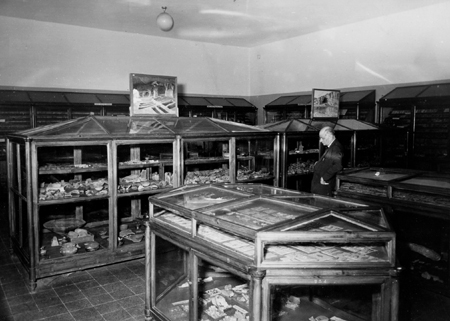
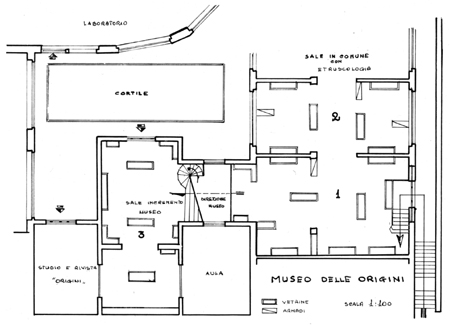
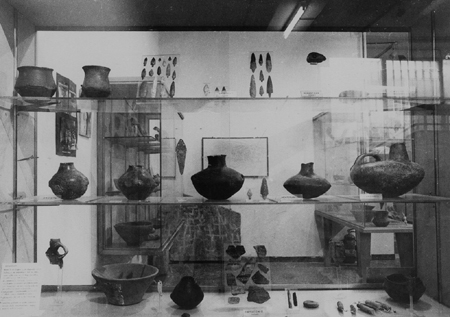
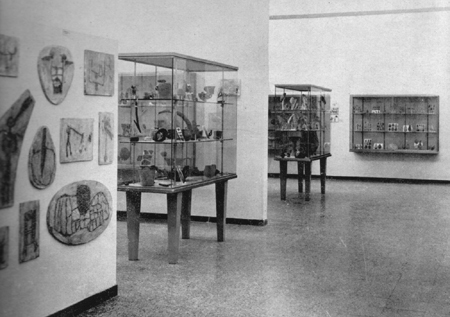
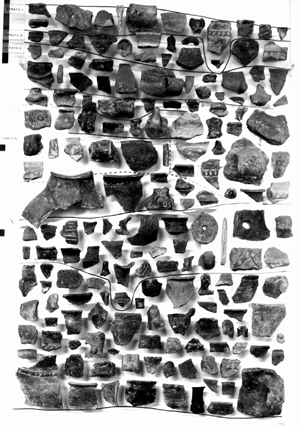
The large panel containing the stratigraphy of Coppa Nevigata in Apulia, reproduced in half scale, the complex stratigraphic sequence discovered at the site. The site was occupied for millennia, from the Neolithic until the entire Bronze Age. Original artefacts were placed on display on a Plexiglas sheet. Once more a technical expedient was used as support for methodological content, transformed into a message: attention to the formation of the archaeological deposit, the importance of stratigraphic excavation and the reading of anthropic states in their temporal occurrence. The concept of context was highlighted, indispensable for the allocation of even the smallest of fragments, in a correct interpretative framing.